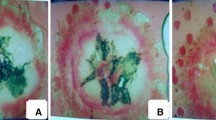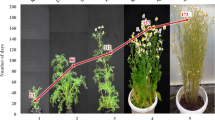Abstract
Reproductive barriers often exist in the crosses between Dendranthema grandiflorum (Ramat.) Kitamura and its wild species and seriously result in low seed set, consequently reducing breeding efficiency. For the purpose of revealing the factors leading to low seed set, we investigated pollen viability, germination behavior of pollen grains on stigmas and embryo development in the crosses between D. grandiflorum and three wild species, D. nankingense (Nakai) Tzvel., D. indicum (L.) Des Moul. and D. zawadskii (Herb.) Tzvel. using technique of paraffin section, and light, fluorescence and scanning electron microscopy. The results indicated pollen viability of three wild species ranged from 20 to 25%. In the cross between D. grandiflorum and D. nankingense, very few pollen grains germinated on stigmas after pollination and most of them germinated abnormally. In addition, normal embryos were observed in 12% ovaries at 8 days after pollination and thereafter all the embryos aborted. In other two crosses, many pollen grains germinated on stigmas and pollen tubes penetrated stigmas normally after pollination. Moreover, normal embryos were observed in over 50% ovaries from 8 to 15 days after pollination in the cross between D. grandiflorum and D. indicum, and seed set was 59%. In the cross between D. grandiflorum and D. zawadskii, normal embryos were observed in 52% ovaries at 8 days after pollination. After that, however, most embryos degenerated and seed set was only 9%. These data suggest that pollen viability has no significant effects on seed set of the three crosses. Very few germinated pollen grains on stigmas and abnormal growth of most pollen tubes before fertilization, and embryo abortion are the main factors causing failure of the cross between D. grandiflorum and D. nankingense, whereas only embryo abortion is a main factor resulting in low seed set in the cross between D. grandiflorum and D. zawadskii and no barriers occur in the cross between D. grandiflorum and D. indicum.







Similar content being viewed by others
References
Aleemullah M, Haigh AM, Holford P (2000) Anthesis, anther dehiscence, pistil receptivity and fruit development in the Longum group of Capsicum annuum. Aust J Exp Agric 40:755–762
Anderson NO (2007) Chrysanthemum. Dendranthema × grandiflora Tzvelv. In: Anderson NO (ed) Flower breeding and genetics. Springer, Netherlands, pp 389–437
Buitendijk JH, Pinsonncaux N, van Donk AC, Ramanna MS, van Lammeren AAM (1995) Embryo rescue by half-ovule culture for the production of interspecific hybrids in Alstroemeria. Sci Hortic 64:65–75
Chen JY (2001) Classification system for Chinese flower cultivars. China Forestry Press, Peking, pp 218–231
Chen JY, Wang SQ, Wang XC, Wang PW (1995) Thirty years’ studies on breeding ground-cover chrysanthemum new cultivars. Acta Hortic 404:30–36
Chen FD, Chen PD, Fang WM, Li HJ (1998) Cytogenetics of F1-hybrids between two small-headed cultivars of Dendranthema grandiflorum and two wild species Dendranthema species. Acta Hortic Sinica 25:308–309
Clarke HJ, Wilson JG, Kuo I, Lülsdorf MM, Mallikarjuna N, Kuo J, Siddique KHM (2006) Embryo rescue and plant regeneration in vitro of selfed chickpea (Cicer arietinum L.) and its wild annual relatives. Plant Cell Tiss Organ Cult 85:197–204
Dafni A, Firmage D (2000) Pollen viability and longevity: practical ecological and evolutionary implications. Plant Syst Evol 222:113–132
Dai SL, Chen JY (1996) Artificial interspecific cross among seven species of Dendranthema in China. J Beijing For University 18:16–22
Datson PM, Murray BG, Hammett KRW (2006) Pollination systems, hybridization barriers and meiotic chromosome behaviour in Nemesia hybrids. Euphytica 151:173–185
De Graaf BHJ, Derksen JWM, Mariani C (2001) Pollen and pistil in the progamic phase. Sex Plant Reprod 14:41–55
Douzono M, Ikeda H (1998) All year round productivity of F1 and BC1 progenies between Dendranthema grandiflorum and D. shiwogiku. Acta Hortic 454:303–310
Eeckhaut T, Van Laere K, De Riek J, Van Huylenbroeck J (2006) Overcoming interspecific barriers in ornamental plant breeding. In: Teixeira da Silva J (ed) Floriculture, ornamental and plant biotechnology: advances and topical issues, 1st edn. Global Science Books, London, UK, pp 540–551
Franklin-Tong VE (1999) Signaling and the modulation of pollen tube growth. Plant Cell 11:727–738
Fukai S, Nagira T, Goi M (2000) Cross compatibility between chrysanthemum (Dendranthema grandiflorum) and Dendranthema species native to Japan. Acta Hortic 508:337–340
Heslop-Harrison Y (2000) Control gates and micro-ecology: the pollen-stigma interaction in perspective. Ann Bot 85:5–13
Hodnett GL, Burson BL, Rooney WL, Dillon SL, Price HJ (2005) Pollen–pistil interactions result in reproductive isolation between Sorghum bicolor and divergent Sorghum species. Crop Sci 45:1403–1409
Huang ZH, Zhu JM, Mu XJ, Lin JX (2004) Pollen dispersion, pollen viability and pistil receptivity in Leymus chinensis. Ann Bot 93:295–301
Jena KK, Khush GS (1990) Introgression of genes from Oryza officinalis Well ex Watt to cultivated rice, O. sativa L. Theor Appl Genet 80:737–745
Jiang XW, Bao MZ, Xue D, Zhou DH (2002) Pest species, audio-visual characteristics and damage of chrysanthemum in China. Hubei Agric Sci 6:74–77
King IP, Forster BP, Law CC, Cant KA, Orford SE, Gorham J, Reader S, Miller TE (1997) Introgression of salt-tolerance genes from Thinopyrum bessarabicum into wheat. New Phytol 137:75–81
Knox RB, Willing RR, Ashford AE (1972) Role of pollen wall proteins as recognition substances in interspecific hybridization in poplars. Nature 237:381–383
Koshy KC, Jee G (2001) Studies on the absence of seed set in Bambusa vulgaris. Curr Sci 82:375–378
Lee CB, Page LE, McClure BA, Holtsford TP (2008) Post-pollination hybridization barriers in Nicotiana section Alatae. Sex Plant Reprod 21:183–195
Lester RN, Kang JH (1998) Embryo and endosperm function and failure in Solanum species and hybrids. Ann Bot 82:445–453
Li HJ (1993) Chrysanthemums in China. Jiangsu Scientific and Technical Press, Nanjing
Li XL, Chen FD, Zhao HB (2008a) Heredity of several flower characters in Dendranthema. Sci Agric Sinica 41:786–794
Li XL, Chen FD, Zhao HB (2008b) Compatibility of interspecific cross in Dendranthema genus. Acta Hortic Sinica 35:257–262
Malhó R (1998) Pollen tube guidance—the long and winding road. Sex Plant Reprod 11:242–244
Mallikarjuna N, Saxena KB (2002) Production of hybrids between Cajanus acutifolius and C. cajan. Euphytica 124:107–110
Marta AE, Camadro EL, Díaz-Ricci JC, Castagnaro AP (2004) Breeding barriers between the cultivated strawberry, Fragaria × ananssa, and related wild germplasm. Euphytica 136:139–150
Mascarenhas JP (1993) Molecular mechanisms of pollen tube growth and differentiation. Plant Cell 5:1303–1314
Mazzucato A, Olimpieri I, Ciampolini F, Cresti M, Soressi GP (2003) A defective pollen-pistil interaction contributes to hamper seed set in the parthenocarpic fruit tomato mutant. Sex Plant Reprod 16:157–164
Mont J, Iwanaga M, Orjeda G, Watanabe K (1993) Abortion and determination of stages for embryo rescue in crosses between sweet-potato, Ipomoea batatas Lam. (2n = 6x = 90) and its wild relative, I. trifida (H. B. K) G. Don. (2n = 2x = 30). Sex Plant Reprod 6:176–182
Ndoutoumou PN, Toussaint A, Baudoin JP (2007) Embryo abortion and histological features in the interspecific cross between Phaseolus vulgaris L. and P. coccineus L. Plant Cell Tiss Organ Cult 88:329–332
Pellegrino G, Bellusci F, Musacchio A (2005) Evidence of post-pollination barriers among three colour morphs of the deceptive orchid Dactylorhiza sambucina (L.) Soó. Sex Plant Reprod 18:179–185
Ram SG, Sundaravelpandian K, Kumar M, Vinod KK, Bapu JRK, Raveendran TS (2006) Pollen-pistil interaction in the inter-specific crosses of Sesamum sp. Euphytica 152:379–385
Ram SG, Ramakrishnan SH, Thiruvengadam V, Bapu JRK (2008) Prefertilization barriers to interspecific hybridization involving Gossypium hirsutum and four diploid wild species. Plant Breeding 127:295–300
Singh AK (1998) Hybridization barriers among the species of Arachis L., namely of the sections Arachis (including the groundnut) and Erectoides. Genet Resour Crop Evol 45:41–45
Spielman M, Scott RJ (2008) Polyspermy barriers in plants: from preventing to promoting fertilization. Sex Plant Reprod 21:53–65
Ssebuliba R, Talengera D, Makumbi D, Namanya P, Tenkouano A, Tushemereirwe W, Pillay M (2006) Reproductive efficiency and breeding potential of East African highland (Musa AAA-EA) bananas. Field Crops Res 95:250–255
Teng NJ, Chen T, Jin B, Wu XQ, Huang ZH, Li XG, Wang YH, Mu XJ, Lin JX (2006) Abnormalities in pistil development result in low seed set in Leymus chinensis (Poaceae). Flora 201:658–667
Teng NJ, Chen FD, Jiang ZC, Fang WM, Chen TT (2008) Detection of genetic variation by RAPD among chrysanthemum plantlets regenerated from irradiated calli. Acta Hortic 766:413–419
Wang PW, Chen JY (1990) Studies on breeding ground-cover chrysanthemum new cultivars. Acta Hortic Sinica 17:223–228
Wilcock C, Neiland R (2002) Pollination failure in plants: why it happens and when it matters. Trends Plant Sci 17:270–277
Wilhelmi LK, Preuss D (1997) Blazing new trails (pollen tube guidance in flowering plants). Plant Physiol 113:307–312
Xiao JH, Gradillo S, Ahn SN, McCouch SR, Tanksley SD, Li JM, Yuan LP (1996) Genes from wild rice improve yield. Nature 384:223–224
Zhang CQ, Hong B, Li JK, Gao JP (2005) A simple method to evaluate the drought tolerance of ground-cover chrysanthemum rooted cuttings. Scientia Agric Sinica 38:789–796
Zhao HB, Chen FD, Fang WM (2005) Pollen germination in vitro of chrysanthemum cultivars with small inflorescences and several species of Dendranthema. J Nanjing Agric University 28:22–27
Acknowledgments
This work was supported by the National Science Fund of China (30700081), China Postdoctoral Science Foundation (20060400945), Jiangsu Planned Projects for Postdoctoral Research Funds (0602043B) and Program for New Century Excellent Talents in University (NCET-06-0489).
Author information
Authors and Affiliations
Corresponding author
Rights and permissions
About this article
Cite this article
Sun, CQ., Chen, FD., Teng, NJ. et al. Factors affecting seed set in the crosses between Dendranthema grandiflorum (Ramat.) Kitamura and its wild species. Euphytica 171, 181–192 (2010). https://doi.org/10.1007/s10681-009-0005-6
Received:
Accepted:
Published:
Issue Date:
DOI: https://doi.org/10.1007/s10681-009-0005-6




